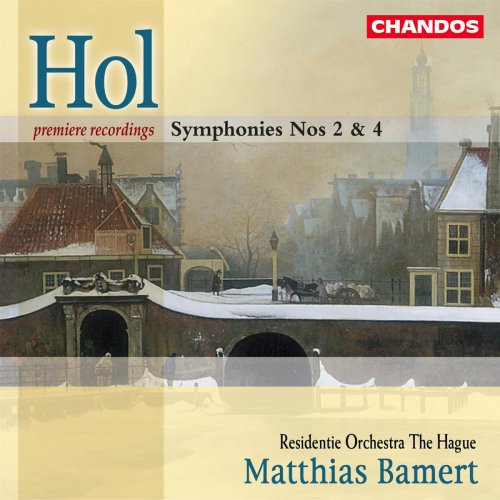
Matthias Bamert, Residentie Orchestra The Hague - Richard Hol: Symphonies Nos. 2 & 4 (2001)
BAND/ARTIST: Matthias Bamert, Residentie Orchestra The Hague
- Title: Richard Hol: Symphonies Nos. 2 & 4
- Year Of Release: 2001
- Label: Chandos
- Genre: Classical
- Quality: FLAC (tracks)
- Total Time: 01:02:30
- Total Size: 255 Mb
- WebSite: Album Preview
Tracklist:
Symphony No. 2 in D Minor, Op. 44 (Richard Hol)
1. I. Lento - Allegro molto agitato 12:13
2. II. Preghiera: Adagio - Etwas bewegt - Più lento 09:42
3. III. Presto 04:46
4. IV. Allegro con brio 06:15
Symphony No. 4 in A major (Richard Hol)
5. I. Andante sostenuto - Allegro moderato - Tranquillo - Andante sostenuto 09:22
6. II. Presto 05:01
7. III. Adagio non troppo 08:56
8. IV. Allegro vivace 06:15
Performers:
Residentie Orchestra The Hague
Matthias Bamert
Symphony No. 2 in D Minor, Op. 44 (Richard Hol)
1. I. Lento - Allegro molto agitato 12:13
2. II. Preghiera: Adagio - Etwas bewegt - Più lento 09:42
3. III. Presto 04:46
4. IV. Allegro con brio 06:15
Symphony No. 4 in A major (Richard Hol)
5. I. Andante sostenuto - Allegro moderato - Tranquillo - Andante sostenuto 09:22
6. II. Presto 05:01
7. III. Adagio non troppo 08:56
8. IV. Allegro vivace 06:15
Performers:
Residentie Orchestra The Hague
Matthias Bamert
Chandos’ Dutch music series continues with this second disc of Hol symphonies. As with Symphonies 1 and 3, Nos. 2 and 4 display Hol’s mastery of symphonic form, orchestration, and counterpoint. They also reveal the prevailing influence of Mendelssohn, Schubert, Schumann, and Brahms (with occasional suggestions of Dvorák). Mendelssohn figures most in Symphony No. 2, with an opening movement that rides along like many of the German composer’s tempestuous allegros, followed by a fleet-footed and colorful scherzo. Symphony No. 4 begins with a slow introduction before launching into the driving allegro proper. There’s energy aplenty in the following scherzo and much tender emotion in the adagio. The finale, like that of the Second Symphony, creates a festive atmosphere based on folk-dance rhythms.
As I said of the earlier release (type Q1409 in Search Reviews), this is pleasant-sounding music, but it now seems a bit ordinary, especially since there’s little significant stylistic distinction among the four symphonies. After Symphony No. 1, Hol’s melodic gifts failed to rise to the level of his models (but then, few composers of the 19th century managed that, which is probably why the list of “greats” remains pretty consistent). This certainly doesn’t prevent Matthias Bamert (whose enthusiasm for the obscure and the neglected seems unflagging) from serving up another pair of spirited performances with the Residentie Orchestra. Chandos’ full-sounding recording is a little less bright than its usual productions, but otherwise it’s fine. Recommended for those who’d like to step outside the standard repertoire, but not too far.
As I said of the earlier release (type Q1409 in Search Reviews), this is pleasant-sounding music, but it now seems a bit ordinary, especially since there’s little significant stylistic distinction among the four symphonies. After Symphony No. 1, Hol’s melodic gifts failed to rise to the level of his models (but then, few composers of the 19th century managed that, which is probably why the list of “greats” remains pretty consistent). This certainly doesn’t prevent Matthias Bamert (whose enthusiasm for the obscure and the neglected seems unflagging) from serving up another pair of spirited performances with the Residentie Orchestra. Chandos’ full-sounding recording is a little less bright than its usual productions, but otherwise it’s fine. Recommended for those who’d like to step outside the standard repertoire, but not too far.
As a ISRA.CLOUD's PREMIUM member you will have the following benefits:
- Unlimited high speed downloads
- Download directly without waiting time
- Unlimited parallel downloads
- Support for download accelerators
- No advertising
- Resume broken downloads


